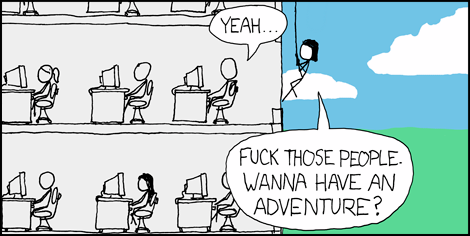Career
Venturing beyond the office, with Computer Science

xkcd's Interesting Life
There is this perception that a typical programming job involves being locked away in a grey cubicle at some LargeCorp Inc., buried in mediocre tasks, and rarely seeing the light of day. While this grim illustration is not exactly the case (or I was simply fortunate enough to avoid such fate), there is some motive to such stereotype. So just as a classic xkcd suggests:
“Quick, fashion a climbing harness out of cat-6 cable and follow me down.”
We’ll be going on an adventure through on-site programming positions that are anything but typical.
Inside a shipping container, in the middle of an ocean…

Original photo by cfarivar, reused from another boat post
The first location comes from the experiences of Reto Meier, who’s job took him out to sea — When Offshoring Your Development Team Means Buying a Boat.
By the time you realise their office isn’t exactly in Portland, you’re sitting in a 10′ sea container floating in the middle of the Indian Ocean pressing a button every 108 minutes.
It’s a pretty intense story, and is worth a read.
South pole

Original photo by µµ
How about the South Pole? The IceCube Neutrino Observatory has a job posting — just some requirements: Linux, security, Perl/Python/Java, and to “deploy to the South Pole in early October for 12-13 months with no possibility of leaving during the winter months from mid-February to mid-October”.
To be fair, the science is pretty amazing, and some people would jump at an opportunity to get close to this kind of research.
Race around the world

Audi preparing for Pikes Peak Hill International Climb
What about debugging C# “memory leaks” (or as close as one can get to such in a managed memory language) in Mojave desert, during DARPA’s Grand Challenge?
Or racing to the clouds with an autonomous Audi in a Pikes Peak International Hill Climb?
As Universities and research groups push autonomous cars to their limits, various races and challenges will take the technical teams throughout the world.
Out of this world

STS-127 mission, via TopTechWriter.US
The sky isn’t even the limit. Julie Payette, a Canadian Computer Engineer, has “conducted research in computer systems, natural language processing and automatic speech recognition”. She has then gone to space. Twice.
In 1999 Julie has gone on STS-096 as a crewmember to operate the Canadarm robotic arm. In 2009 she has gone on STS-127 as the flight engineer, operating robotic technology.
Scott Maxwell has gone from writing software to driving the Mars rover. Not really on-site, but “it’s the greatest job on two planets.”






Thats interesting,, Tony
Porgramming & coding can be done anywhere, provided you have the your ultimate machines with you.
Reply to comment
Nothing encourages good coding practice like working without a debugger on a system that can physically run away from you.
…or fly away, for that matter.
Reply to comment
whatever people say is not important, if you enjoy with the jobs so just do it..:D
Reply to comment
I once thought of coding in a shopping mall, but backed off as i thought that it would be too much of a show off rather than anything else
Reply to comment